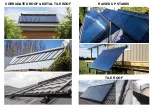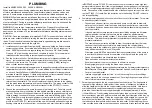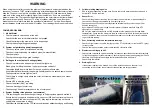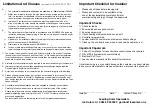
1. Installations will run most efficiently with 3/8” pipe runs with the Ice Solar standard
system configurations. Ensure the whole 20m length of 3/8” (9mm) copper coil is
used. NOTE: flare connectors require flaring tool that has a 3/8” (9mm) setting.
Only use 1/2” pipe if running more than 3 collectors in series. Or for commercial
installations size is according to system specific configuration.
2. Run the hot return line fist. Select the shortest pipe run for highest collection effi-
ciency. ie closest side of solar collector’s manifold to the cylinder. Use the balance
of the coil for the return line. This helps with the self cooling (CMAX) setting for
when cylinder reaches temperature.
3. Use only high temperature jointing methods. In stagnation the solar collector can reach
temperatures of up to 200 degrees C. ie. braise welding for roof fittings is failsafe (not
on air vent), Gasoila/Teflon or Heldite/Teflon are both acceptable for these products
are rated to over 200 degrees C. Hemp and graphite is not recommended. Use high
temperature washers for fixing swivel unions onto manifold.
4. Connect air vent AAV (vertical position) and probe assembly onto the hot water
return side of the manifold. The air vent captures air before it returns to the cylinder
and the probe reads temperature as it leaves the manifold. The probe socket is IP68
rated for a secure weather and bird resistant socket for the PT1000 (T1) sensor.
5. Choose the penetration entry points for copper pipe through roof. Take into consid-
eration exposure from ground view (ie. hide behind manifold to reduce visibility for a
tidy job). Ensure no roof support members will interfere with penetration points, and
there is enough room to achieve nice connection onto manifold fixing points. Then
drill a 25mm-32mm hole through highest point of roof profile for the 3/8” (9mm) pipe
through roof flashing. Drill a second 10mm-12mm hole through highest part of roof
profile for the PT1000 (T1) cable that will line up with the cable penetration lug in the
flashing, there are two to choose from, so choose which ever is easiest for cable run.
PLUMBING
IMPORTANT ensure PT1000 (T1) cable can not come in contact with the high tem-
perature return pipe and that it can not get damaged by sharp edges of roof material.
Carefully cut high temperature flashing at the level above the first rib, this is the 3/8”
mark. Choose one of the separate cable nibs of the flashing and cut top of this nib to
run the PT1000 (T1) cable. Run the insulation up to the flashing DO NOT run insula-
tion through flashing.
6. Complete plumbing as shown on schematic of front cover of this manual. Turn water
on and check system for leaks.
• Connect and close ball valves, non-return and pump on cold side to draw cold
water up to solar panel. Install ball valve before pump and after non-return valve
so that these items can be easily serviced in the future without draining the water
from the manifold.
• It is good practice to create thermal breaks if possible by bringing the hot water
return pipe below the level that it enters into the cylinder by approximately
200mm, then back up into the cylinder. This prevents heat loss by heat drifting
up the line. This is particularly important for solar/wetback installations and low
pressure installations.
• The circulation pump must be installed to draw the cooler water from the lower
section of the cylinder and circulate this water through the collector before
returning back to the cylinder at a point higher than the draw-off (150mm-200mm)
using dedicated solar ports or a 4-Way valve.
• Circulation pump MUST be mounted so that the cylindrical shape of the pump is
in a horizontal position to avoid accumulation of air that will burn the pump out.
• Check all connections are complete then fill cylinder.
• Open ball valves and check whole system for leaks.
• Ensure automatic air vent on roof is open to allow air to escape.
• Bleed (purge) pump of air, using the bleed screw on pump.
• Setting Pump Speed – set pump speed according to the hot water systems pressure
Mains Pressure = Pump Speed 1: Medium Pressure = Speed 2 : Low Pressure = Speed 3
• Cover air vent with jacket.
• Insulate copper pipe above roof line. It is not necessary to cover brass fittings
unless system is in a corrosive environment. Covering fittings can create difficul-
ties in future maintenance of system.
7. Smear heat past around the top copper head of each heat-pipe. The heat-paste is
required for high efficiency heat transfer; it also acts as a lubricant on installation to
allow the Heatpipe to slide into the copper socket inside the manifold. Hold thumb
over tube-collar to keep these components together against top of borosilicate
glass tube, then slide the inner copper heat-pipe out by approximately 6-8 inches
(150mm-200mm). Gently resting bottom end of glass tube on foot rail, and holding
onto inner copper pipe, look up into manifold, and slide tip of Heatpipe all the way up
into copper manifold socket. Giving the copper pipe a little wriggle as it goes in will
ensure you feel it slide all the way up into this socket. Then move the glass up with
the tube-collar to the manifold, and screw on the tube-collar. Still holding the glass so
it can not slide down, slide on the tube cup base and ensure it locks securely into place
Install to ASNZS3500.4 G12, G12AS2, NZS3501
When installing or repositioning cylinders ensure that parts have access for ease
of future maintenance and operation, in particular elements, anodes, valves and
pumps. Ensure pumps are positioned with accessible air bleed and speed dial.
WARNING: Systems must be installed so that there is a minimum of 2 meters head
of pressure that is continuously maintained above the location of the manifold (top
of solar collector). Failing to provide sufficient pressure can result in shortened life
expectancy of pump and will void warranty.
WARNING: Only use high temperature rated valves. Pipework for cylinder cold
feeds should be done in copper from the valve kit to the cylinder, as backwater ex-
pansion can be, at times, of high temperature that plastic plumbing systems are not
suitable for.
CAUTION: Once the heat-pipes are installed DO NOT close both hot and cold ball
valves to solar collector without draining the manifold, as heat expansion may create
leaks. One of these valves should always remain opened during maintenance to
allow water to expand back into the cylinder.































